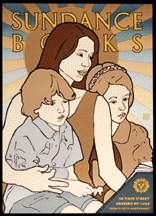 (#175) SUNDANCE BOOKS
(#175) SUNDANCE BOOKS
http://www.sundancebooks.com/:
Edition of 1731 of which 125 copies are signed 1-125, 26 copies are signed A-Z as artist's proofs; 1 is signed as a dedication copy, and three sets are signed as progressives.
 (#175) SUNDANCE BOOKS
(#175) SUNDANCE BOOKS
http://www.sundancebooks.com/:
Edition of 1731 of which 125 copies are signed 1-125, 26 copies are signed A-Z as
artist's proofs; 1 is signed as a dedication copy, and three sets are signed as progressives.
September 7, 1997 18" x 24" 12 colors
Models: Susan, Luisa and Brennan Popovic
Client: Barry Caplan, Sundance Books, 106 Main Street, Geneseo NY 14454, Telephone: 716.243.0102 or 716.243.2250, FAX: 716.243.2799, e-mail: sun@sundancebooks.com
Dedication copies: Barry Caplan, the Popovic family, Harriet & Murray Caplan, Shelly & Bob, JoAnn & Joseph Amedore, Mary Ann & George Amedore, Mary Lou & Armand Amedore, Josephine & Armond Amedore, Bob Helm, Jim, George Heath, Judy & Paul, Candy & Eric, Carol & Mark, LeeAnn & Karl, Jackie & George, Grayce & Fred, T'res & John, Bev & Phil, Debbie & Randy, Linda & Pete, Sue & Jim, Buzzo, Jane & Gary, Peggy & Jerry, Ellie, Patty & Mike
Children copy their parents. There's no "do as I say, not as I do," about it. My father grew up in the slums of Milwaukee, and out of desperate necessity, one day sought refuge from neighborhood bullies by running into the public library. He spent a lot of time in the reading room after that, and an adolescent delight in pulp science fiction stimulated an interest in science itself. It wasn't just because he learned to love reading in the safe haven of the library that he went on to become a civil engineer. There were plenty of other reasons, but that lucky dodge made a big difference.
My grandmother was a schoolteacher, and my mother took those skills to her own children. She read me my favorite story, "The Little Engine That Could," so many times that I had it memorized cold. If she left something out, or changed the story in any way, I interrupted impatiently and demanded that the story be read precisely as it was set down. This oft-repeated exposure to a particular set of printed pages, combined with my grandmother's phonics instruction, seemed to do the trick. When I was about three years old, I clearly recollect reading a word for the first time: it was a STOP sign, and I could actually read it. S-T-O-P spells "stop." A whole world of silent speech opened up before me.
I read under the covers with a flashlight when I was supposed to be asleep. I sometimes read rather than come to meals. I became afraid that the book would go on without me, that the unfolding Mississippi might flow on and be lost unless I read up every drop. Reading became an escape from my parents and seven brothers and sisters and the dog and the cat and the bird and the fish and all the clamor and confusion that was an ordinary part of every day life, all day long.
As a child, my father escaped into a world of books, where he was safe and welcome. As a grown man, he read on the bus to and from work, pleasure sandwiched between the responsibilities of work and home. My mother rose early to read in the quiet privacy of her sleeping family, before the household awakened and demanded her undivided attention.
There's no trick to teaching children to read, or instilling in them a love of learning. Just do it yourself.
"Preachers say, Do as I say, not as I do." John Selden (1584 - 1654), Table Talk, "Preaching."
"The Little Engine That Could," by Watty Piper (pseudonym of Mable Caroline Bragg), 1930. My exposure to the story was through the set of children's books, "My Book House," edited by Olive Beaupré Miller.